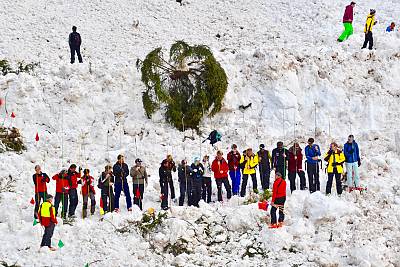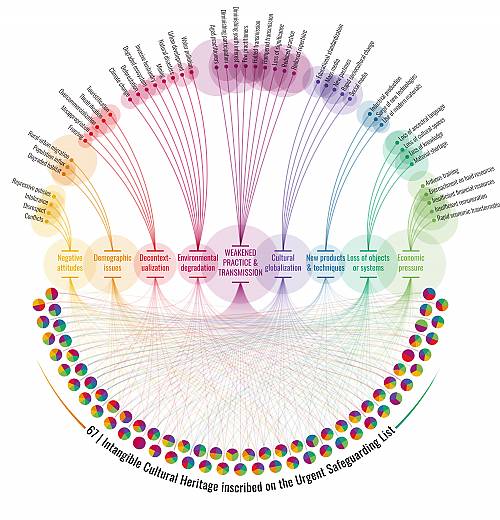Why living heritage in emergencies?

© Friedrich Juen, 2012
Living heritage throughout the world is increasingly affected by emergencies, including conflicts and disasters caused by natural and human-induced hazards. On the one hand, emergencies directly threaten the transmission and viability of intangible cultural heritage, which provides a crucial foundation for the identity and wellbeing of communities, groups and individuals. On the other hand, intangible cultural heritage is a valuable resource for communities to strengthen resilience, reduce vulnerabilities and help communities prepare for, respond to and recover from emergencies. This is why the safeguarding of intangible cultural heritage in emergencies is of utmost importance and indivisible from the protection of the lives and wellbeing of its bearers.
Our approach
Decisions/Resolutions: 11.COM 15, 12.COM 15, 13.COM 11, 14.COM 13, 8.GA 9
Under the 2003 Convention, UNESCO supports States Parties to safeguard intangible cultural heritage in a wide range of emergency contexts. Its approach is supported by the operational principles and modalities for safeguarding intangible cultural heritage in emergencies, which were endorsed by the Intergovernmental Committee at its fourteenth session in 2019 (Decision 14.COM 13).
These provide guidance to States Parties and other relevant national or international stakeholders on how best to ensure that intangible cultural heritage is most effectively engaged and safeguarded in an emergency. In line with the 2003 Convention, they promote a community-based approach which recognizes the primary role that communities play in identifying how their intangible cultural heritage may be at risk and the measures needed to safeguard it, as well as how it might be best drawn upon to support resilience and recovery.
How UNESCO can help

© UNESCO
For countries affected by emergencies, there are different forms of support available.
International assistance
The Intangible Cultural Heritage Fund can provide technical and financial assistance to support safeguarding activities in emergencies. Under paragraph 50 of the Operational Directives, an emergency request for assistance can be made when a State Party finds itself ‘unable to overcome on its own any circumstance due to calamity, natural disaster, armed conflict, serious epidemic or any other natural or human event that has severe consequences for the intangible cultural heritage as well as communities, groups and, if applicable, individuals who are the bearers of that heritage’.
Listing mechanisms
The Convention’s Lists may provide an opportunity to raise international awareness of intangible cultural heritage elements that contribute to preparing for, responding to and recovering from disasters and/or conflicts. In particular, the List of Intangible Cultural Heritage in Need of Urgent Safeguarding (see criteria) could serve to mobilize international cooperation and assistance for stakeholders to undertake appropriate safeguarding measures for elements threatened by a specific disaster and/or conflict.
Capacity building
The global capacity-building programme offers tailored support to strengthen capacities for safeguarding intangible cultural heritage in conflict and disaster situations. Its international network of more than 150 heritage experts can help countries and stakeholders to implement UNESCO’s approach in line with the 2003 Convention. Dedicated training units on disaster risk reduction (Unit 63 and 64) and safeguarding living heritage in situations of conflict and forced displacement(Unit 65 and 66) are available on the capacity-building materials repository.
Other assistance
The Heritage Emergency Fund is a multi-donor fund for the protection of heritage in emergency situations. It was created by UNESCO to finance activities and projects that enable the Organization to assist its Member States in protecting natural and cultural heritage from disasters and conflicts by more effectively preparing for and responding to emergencies.Activities related to emergencies
| Country | Activities | Date |
|---|---|---|
| Bahamas, Belize, Fiji, Tonga Vanuatu | Capacity building for safeguarding intangible cultural heritage in emergencies in Small Island Developing States (SIDS) in the Pacific and the Caribbean - read more | 2022-2025 |
| Cameroon | Strengthening capacities for safeguarding intangible cultural heritage in situations of conflict and forced displacement - read more | 2021-2025 |
| Honduras and Philippines | Strengthening capacities for safeguarding intangible cultural heritage in disaster contexts - read more | 2020-2021 |
| Niger | Safeguarding the intangible cultural heritage of Niger in a situation of urgency and for the resilience of displaced populations - pilot project in Tillabéry and Diffa - read more | 2018-2021 |
| Colombia | Intangible cultural heritage as a basis for resilience, reconciliation and construction of peace environments in Colombia’s post-agreements - read more | 2018-2020 |
| Cote d’Ivoire | Inventory of the intangible cultural heritage present in Côte d’Ivoire in view of its urgent safeguarding - read more | 2015-2018 |
| Democratic Republic of the Congo | Community-based needs identification for the safeguarding of intangible cultural heritage in Nord-Kivu - read more | 2017 |
| Mali | Inventory of intangible cultural heritage in Mali with a view to its urgent safeguarding - read more | 2013-2016 |
| Vanuatu | Safeguarding indigenous vernacular architecture and building knowledge in Vanuatu - read more | 2015 |